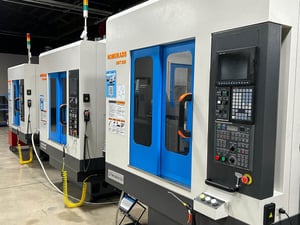Understanding the ROI of a Dedicated Small Parts Cell
When evaluating capital equipment, the conversation often comes down to return on investment (ROI). For shops machining medium to high volumes of small parts, one of the most overlooked ways to accelerate ROI is by dedicating the right equipment to the right type of work. In this case, it often boils down to making use of compact machining centers. Instead of tying up oversized VMCs and HMCs with jobs they weren’t designed for, a dedicated small parts cell can transform both productivity and profitability.
Why a Dedicated Cell Matters
Many job shops run a wide mix of part sizes. The larger machines on the floor are usually versatile enough to handle almost anything, but that versatility comes at a cost. Running small-part jobs on machines built for larger workpieces creates inefficiencies that compound quickly:
- Longer tool travel distances. Increase of non-cutting cycle time has a major impact on throughput and profitability.
- Underutilized spindle horsepower and torque capabilities.
- More floor space consumed than the job truly requires.
- Power consumption. Larger machines generate more heat and consume significantly more power.
By dedicating a small parts cell, whether that’s one or multiple compact machining centers (depending on a specific application or shop needs), you free up your larger equipment for the work it was intended to handle, while giving small-part production a faster, more cost-effective platform.

ROI in Action: Sample Calculation
Consider a job shop machining stainless steel components in batches of 2,500 parts. Running the job on a full-sized VMC takes 20 minutes per part. The same program, transferred with minimal adjustment to a compact machining center, runs in 17 minutes per part.
- VMC cycle time: 20 minutes × 2,500 parts = 50,000 minutes (833 hours)
- Compact machining center cycle time: 17 minutes × 2,500 parts = 42,500 minutes (708 hours)
That’s a 15% reduction in cycle time. For a shop running multiple orders per month, the savings equate to hundreds of hours annually resulting in increases of capacity and profitability. The hours saved can be redeployed to additional jobs while directly translating the savings in additional profits gained.
If machine operating costs average $85/hour (including labor, utilities, and maintenance), the difference in this example is:
- 833 hours × $85 = $70,805
- 708 hours × $85 = $60,180
Annual savings (per job): $10,625
Multiply that by several recurring small-part orders, and the ROI on the compact machine quickly becomes clear.
(Note: these are illustrative sample calculations based on several similar results achieved by real job shops. Actual results depend on part geometry, material, tooling, and setup.)
Case in Point: S-4 Manufacturing
In practice, these numbers aren’t just theoretical. S-4 Manufacturing compared their cycle times running stainless steel parts on a larger 40-taper mill versus a compact machining center. The result:
- 40-Taper Cycle Time: 15 minutes, 12 seconds
- Compact Cycle Time: 13 minutes, 2 seconds
On an order of 2,300 pieces, that difference translated into meaningful time savings and a clear advantage in both throughput and immediate and additional profitability.
.jpg?width=467&height=351&name=NOMURADS_MILLING_FACTORYIMAGES%20(22).jpg)
Beyond the Numbers: Floor Space and Flexibility
ROI isn’t just about cycle time. Compact machining centers take up less square footage than full-sized VMCs or HMCs. For a job shop where every square foot counts, that means:
- More spindles in the same footprint.
- Flexibility to add automation for lights-out running.
- Capacity to diversify and take on additional work without expanding the shop floor.
- Power reduction relative to shop size.
The result is a multiplier effect: faster cycle times, lower cost per part, lower energy costs, and more parts produced in the same space.
Who Should Consider a Dedicated Small Parts Cell?
- Job shops with recurring medium to high-volume small-part work.
- Shops experiencing bottlenecks where larger machines are tied up with jobs they aren’t optimized for.
- Decision-makers looking for quick payback on capital equipment while increasing profit margin per part.
The Takeaway
Achieving a quick and positive ROI on CNC machines is often framed in several ways. But a key point to always consider is how a machine fits into your specific production reality. Matching the machine to the job and dedicating a compact machining center (or several) as a small parts cell, ensures that your equipment investment is working at peak efficiency.
The equation is simple: lower cycle time, lower operating cost, and capacity gains equals increased profit margins. That’s the power of dedicated compact machining centers.
About Nomura DS Milling Machines
Nomura DS compact machining centers are purpose-built for small-part production. With faster cycle times, reduced floor space requirements, and the precision needed for repeated, high-volume work, they deliver a measurable return on investment for job shops. Nomura DS milling machines help shops boost throughput and profitability without sacrificing accuracy.


